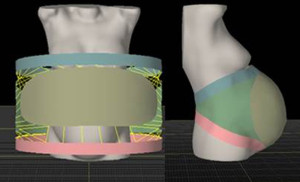
Researchers at Drexel University, Philadelphia, Pa., are combining fashion design with wireless technology to produce a belly band that will be able to monitor uterine contractions and fetal heart rate in real time.
The band, which is in prototype production in the Shima Seiki Haute Technology Lab in Drexel’s Expressive & Creative Interaction Technologies (ExCITe) Center, could be used to monitor high-risk pregnancies, women near their due dates or as a quick, noninvasive procedure during a routine check-up, according to Owen Montgomery, M.D., head of obstetrics and gynecology at Drexel’s College of Medicine and one of the researchers working on the project.
Montgomery and Genevieve Dion, fashion design professor and director of the technology laboratory, are working with engineering researchers in a collaboration supported by the Coulter-Drexel Partnership for Innovation in the School of Biomedical Engineering, Science & Health Systems.
Dion uses Shima Seiki’s software and computerized knitting machines to incorporate new types of yarns into the garments she produces. With a three-dimensional digital rendering of the band, Dion can accurately design it to fit snugly over the midsection of the expecting mother before it is programmed to be knitted. Using electrically conductive thread, the knitting machines are programmed to seamlessly knit a pattern across the center of the band that serves as a wireless, passive radio frequency identification (RFID) tag. From there, signal processing algorithms developed in Drexel’s Electrical and Computer Engineering labs process the changes in received signal characteristics from the RFID to measure the intensity of the uterine contractions and other medical information from mother and baby.
The belly band will undergo clinical trials over the summer. Its first application is likely to be monitoring uterine contractions and, if successful, continued work could allow it to be used for additional fetal monitoring.
 TEXTILES.ORG
TEXTILES.ORG


